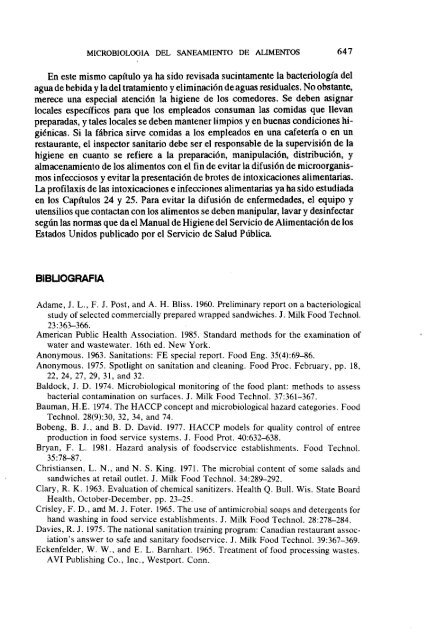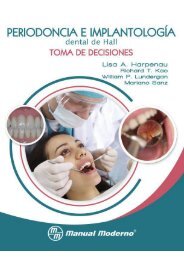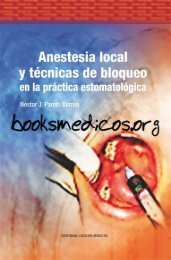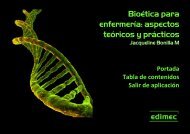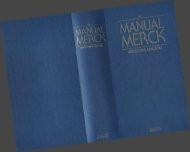- Page 1 and 2:
0 MICROBIOLOGIA DE LOS ALIMENTOS 4.
- Page 3 and 4:
Microbiología de los alimentos’
- Page 5 and 6:
Los autores WILLIAM C. FRAZIER es P
- Page 7 and 8:
! 4 Principios generales en los que
- Page 9 and 10:
1 7 Contaminación, conservación y
- Page 11 and 12:
Prólogo a la cuarta edicion La pri
- Page 13 and 14:
Prólogo a la tercera edición Desd
- Page 15:
Primera parte Alimentos y microorga
- Page 18 and 19:
4 MICROBIOLOGIA DE LOS ALIMENTOS Cu
- Page 20 and 21:
6 MICROBIOLOGIA DE LOS ALIMENTOS se
- Page 22 and 23:
, , 8 MICROBIOLOGIA DE LOS A1,IMENT
- Page 24 and 25:
10 MICROBIOIXXiIA DE 1,OS AIJMENTOS
- Page 26 and 27:
~~ ~ 12 MICROBIOLOGIA DE LOS AIJMEN
- Page 28 and 29:
14 MICROBIOLOGIA DE LOS ALIMENTOS r
- Page 30 and 31:
16 MICROBIOLOGIA DE LOS ALIMENTOS 1
- Page 32 and 33:
18 MICROBIOLOGIA DE LOS ALIMENTOS u
- Page 34 and 35:
20 MICROBIOLOGIA DE LOS ALIMENTOS e
- Page 37 and 38:
Capítulo 2 Microorganismos importa
- Page 39 and 40:
MICROOROANISMOS IMPORTANTES EN MICR
- Page 41 and 42:
MICROORGANISMOS IMPORTANTES EN , Es
- Page 43 and 44:
MICROORGANISMOS IMPORTANTES EN MICR
- Page 45 and 46:
MICROORGANISMOS IMPORTANTES EN MICR
- Page 47 and 48:
MICROORGANISMOS IMPORTANTES EN MICR
- Page 49 and 50:
MICROORGANISMOS IMPORTANTES EN MICR
- Page 51 and 52:
MICROORGANISMOS IMPORTANTES EN MICR
- Page 53 and 54:
MICROORGANISMOS IMPORTANTES EN MICR
- Page 55 and 56:
MICROORGANISMOS IMPORTANTES EN MICR
- Page 57 and 58:
MICROORGANISMOS IMPORTANTES EN MICR
- Page 59 and 60:
MICROORGANISMOS IMPORTANTES EN MICR
- Page 61 and 62:
MICROORGANISMOS IMPORTANIF-5 EN MIC
- Page 63 and 64:
MICROORGANISMOS IMPORTANTES MICROBI
- Page 65 and 66:
MICROORGANISMOS IMPORTANTES EN MlCR
- Page 67 and 68:
MICROORGANISMOS IMPORTANTES EN MICR
- Page 69 and 70:
MICROORGANISMOS IMPORTANTES EN MlCR
- Page 71 and 72:
MICROORGANISMOS IMPORTANTES EN MICR
- Page 73 and 74:
MICROORGANISMOS IMPORTANTES EN MICR
- Page 75 and 76:
MICROORGANISMOS IMPORTANTES EN MICR
- Page 77 and 78:
MICROORGANISMOS IMPORTANTES EN MICR
- Page 79 and 80:
MICROORGANISMOS IMPORTANTES EN MICR
- Page 81 and 82:
MICROORGANISMOS IMPORTANTES EN MICR
- Page 83 and 84:
". MICROORGANISMOS IMPORTANTES EN M
- Page 85 and 86:
MICROORGANISMOS IMPORTANTES EN MICR
- Page 87 and 88:
MICROORGANISMOS IMPORTANTES EN MICR
- Page 89 and 90:
Capítulo 3 . Contaminación de los
- Page 91 and 92:
CONTAMINACION DE LOS ALIMENTOS 77 l
- Page 93 and 94:
CONTAMINACION DE LOS ALIMENTOS 79 r
- Page 95 and 96:
CONTAMINACION DE LOS ALIMENTOS 81 a
- Page 97 and 98:
CONTAMINACION DE LOS ALIMENTOS 83 a
- Page 99 and 100:
~ CONTAMINACION DE LOS ALIMENTOS 85
- Page 101:
CONTAMINACION DE LOS ALIMENTOS 87 S
- Page 104 and 105:
90 MICROBIOLOGIA DE LOS ALIMENTOS !
- Page 106 and 107:
. / ! , 92 MICROBIOLOGIA DE LOS AIJ
- Page 108 and 109:
94 MICROBIOLOGIA DE LOS ALIMENTOS ;
- Page 110 and 111:
96 MICROBIOLOGIA DE LOS ALIMENTOS E
- Page 112 and 113:
98 MICROBIOLOGIA DE 1,OS ALIMENTOS
- Page 114 and 115:
100 MICROBIOLOGIA DE LOS ALIMENTOS
- Page 116 and 117:
102 MICROBIOLOGIA DE LOS ALIMENTOS
- Page 118 and 119:
104 MICROBIOLOGIA DE LOS ALIMENTOS
- Page 121 and 122:
Capítulo 5 Principios generales de
- Page 123 and 124:
ASEPSIA, ELIMINACION DE MICROORCirW
- Page 125 and 126:
ASEPSIA, ELIMINA
- Page 127 and 128:
ASEPSIA, ELIMINACION DE MICROOR
- Page 129 and 130:
ASEPSIA, ELIMINACION DE MICROORGANI
- Page 131:
ASEPSIA, ELIMINA(1ON ¡)E MICROOR(i
- Page 134 and 135:
120 MICROBIOLOGIA DE LOS ALIMENTOS
- Page 136 and 137:
122 MICROBIOLOGIA DE LOS ALIMENTOS
- Page 138 and 139:
124 MICROBIOLOGIA DE LOS ALIMENTOS
- Page 140 and 141:
126 MICROBIOLOGIA DE LOS ALIMENTOS
- Page 142 and 143:
128 MICROBIOLOGIA DE LOS ALIMENTOS
- Page 144 and 145:
130 MICROBIOLOGIA DE LOS ALIMENTOS
- Page 146:
, ( 132 MICROBIOLOGIA DE LOS ALIMEN
- Page 149 and 150:
CONSERVACION MEDIANTE TEMPERATURAS
- Page 151 and 152:
CONSERVACION MEDIANTE TEMPERATURAS
- Page 153 and 154:
CONSERVAClON MEDIANTE TEMPERATURAS
- Page 155 and 156:
CONSERVACION MEDIANTE TEMPERATURAS
- Page 157 and 158:
CONSERVACION MEDIANTE TEMPERATURAS
- Page 159 and 160:
CONSERVACION MEDIANTE TEMPERATURAS
- Page 161 and 162:
CONSERVACION MEDIANTE TEMPERATURAS
- Page 163 and 164:
CONSERVACION MEDIANTE TEMPERATURAS
- Page 165 and 166:
CONSERVACION MEDIANTE TEMPERATURAS
- Page 167 and 168:
CONSERVACION MEDIANTE TEMPERATURAS
- Page 169 and 170:
CONSERVACION MEDIANTE TEMPERATURAS
- Page 171 and 172:
CONSERVACION MEDIANTE TEMPERATURAS
- Page 173 and 174:
Capítulo 7 ~~ Conservación median
- Page 175 and 176:
CONSERVACION MEDIANTE TEMPERATURAS
- Page 177 and 178:
CONSERVACION MEDIANTE TEMPERATURAS
- Page 179 and 180:
CONSERVACION MEDIANTE TEMPERATURAS
- Page 181 and 182:
CONSEIWACION MEDIANI'E TEMPERATLJMS
- Page 183 and 184:
CONSERVACION MEDIANTE TEMPERATURAS
- Page 185 and 186:
CONSERVACION MEDIANTE TEMPERATURAS
- Page 187 and 188:
CONSERVACION MEDIANTE TEMPERATURAS
- Page 189:
CONSERVACION MEDIANTE TEMPERATURAS
- Page 192 and 193:
178 MICROBIOLOGIA DE LOS ALIMENTOS
- Page 194 and 195:
180 MICROBIOLOGIA DE LOS ALIMENTOS
- Page 196 and 197:
I 182 MICROBIOLOGIA DE LOS ALIMENTO
- Page 198 and 199:
I I. 184 MICROBIOLOGIA DE LOS ALIME
- Page 200 and 201:
. . 186 MICKOBIOLOGIA DE I,OS ALIME
- Page 202 and 203:
188 MICROBIOLOGIA DE LOS ALIMENTOS
- Page 205 and 206:
Capítulo 9 Consenración de alimen
- Page 207 and 208:
CONSERVACION MEDIANTE ADITIVOS 193
- Page 209 and 210:
CONSERVACION MEDIANTE ADITIVOS 195
- Page 211 and 212:
CONSERVACION MEDIANTE ADITIVOS 197
- Page 213 and 214:
CONSERVACION MEDIANTE ADITIVOS 199
- Page 215 and 216:
CONSERVACION MEDIANTE ADITIVOS 20 1
- Page 217 and 218:
CONSERVACION MEDIANTE ADITIVOS 203
- Page 219 and 220:
CONSERVACION MEDIANTE ADITIVOS 205
- Page 221 and 222:
CONSERVACION MEDIANTE ADITIVOS 207
- Page 223 and 224:
CONSERVACION MEDIANTE ADITIVOS 209
- Page 225 and 226:
Capítulo 10 Conservación por irra
- Page 227 and 228:
CONSERVACION POR IRRADIACION 213 Ap
- Page 229 and 230:
CONSERVACION POR IRRADIACION 215 po
- Page 231 and 232:
CONSERVACION POR IRRADIACION 217 al
- Page 233 and 234:
CONSERVACION POR IRRADIACION 219 ha
- Page 235 and 236:
~~~ ~ ~~~~ CONSERVACION POR IRRADIA
- Page 237 and 238:
CONSERVACION POR IRRADIACION 223 al
- Page 239:
CONSERVACION POR IRRADIACION 225 Bl
- Page 243 and 244:
~ ~~ ~ Capítulo I 1 - ~- ~- ~- ~ ~
- Page 245 and 246:
CONTAMINACION, CONSERVACION Y AL'I'
- Page 247 and 248:
I CONTAMINACION, CONSERVACION Y ALT
- Page 249 and 250:
CONTAMINACION, CONSERVACION Y ALTER
- Page 251 and 252:
CONTAMINACION, CONSERVACION Y ALTER
- Page 253 and 254:
CONTAMINACION, CONSERVACION Y ALTER
- Page 255 and 256:
CONTAMINACION, CONSERVACION Y AJ,TE
- Page 257 and 258:
CONTAMINACION, CONSERVAClON Y ALTER
- Page 259:
CONTAMINACION, CONSERVACION Y ALTER
- Page 262 and 263:
248 MICROBIOLOGIA DE LOS ALIMENTOS
- Page 264 and 265:
. . 250 MICROBIOLOGIA DE LOS ALIMEN
- Page 266 and 267:
. . 25 2 MICROBIOLOGIA DE LOS ALIME
- Page 268 and 269:
25 4 MICROBIOLOGIA DE LOS ALIMENTOS
- Page 270 and 271:
2s tí I FLORA MSCROBIANA NO ALTERA
- Page 272 and 273:
!. 1 258 MICROBIOLOGIA DE LOS ALIME
- Page 274 and 275:
. S 260 MICROBIOLOGIA DE LOS ALIMEN
- Page 276 and 277:
262 MICROBIOLOGIA DE LOS ALIMENTOS
- Page 278 and 279:
264 MICROBIOLOGIA LOS DE ALIMENTOS
- Page 280 and 281:
266 MICROBIOLOGIA DE LOS ALIMENTOS
- Page 282 and 283:
268 MICROBIOLOGIA DE LOS ALIMENTOS
- Page 284 and 285:
270 MICROBIOLOGIA DE LOS ALIMENTOS
- Page 286 and 287:
272 MICROBIOLOGIA DE LOS ALIMENTOS
- Page 288 and 289:
274 MICROBIOLOGIA DE LOS ALIMENTOS
- Page 290 and 291:
276 MICROBIOLOCJIA DE LOS AIJMENTOS
- Page 292 and 293:
, 2 278 MICROBIOLOGIA DE LOS ALIMEN
- Page 294 and 295:
280 MICROBIOLOGIA DE LOS ALIMENTOS
- Page 296 and 297:
I , .I 282 MICROBIOLOGIA LOS ALIMEN
- Page 298 and 299:
( 1 284 MICROBIOLOGIA DE LOS ALIMEN
- Page 300 and 301:
286 MICROBIOLOGIA DE LOS ALIMENTOS
- Page 302 and 303:
288 MICROBIOLOGIA DE LOS ALIMENTOS
- Page 304 and 305:
290 MICROBIOLOGIA DE LOS ALIMENTOS
- Page 306 and 307:
: I 292 MICROBIOLOGIA DE LOS /,._I
- Page 308 and 309:
294 MICROBIOLOGIA DE LOS ALIMENTOS
- Page 310 and 311:
296 MICROBIOLOGIA DE LOS ALIMENTOS
- Page 312 and 313:
298 MlG'KOBIOLOCrI.4 DE IDS ALIMENT
- Page 314 and 315:
300 MICROBIOLOGIA DE LOS ALIMENTOS
- Page 316 and 317:
! -1 302 MICROBIOLOGIA DE LOS ALIME
- Page 318 and 319:
. I 304 MICROBIO1,OGIA DE ¡,OS ALI
- Page 320 and 321:
306 MICROBIOLOGIA DE LOS ALIMENTOS
- Page 322 and 323:
308 MICROBIOLOCJIA DE LOS ALIMEN1'O
- Page 324 and 325:
310 MICROBIO1,OGIA DE LOS A1,IMENTO
- Page 326 and 327:
312 MICROBIOLOGIA , . -. LOS DE ALI
- Page 328 and 329:
314 MICKOBIOLOGIA DE LOS ALIMENrOS
- Page 330 and 331:
316 4 MICROBIOLOGIA DE LOS ALIMENTO
- Page 332 and 333:
318 MICROBIOLOGIA DE LOS ALIMENTOS
- Page 334 and 335:
320 MICKOBIOLOCJIA DE LOS ALIMENI'O
- Page 336 and 337:
322 MICROBIOLOGIA DE LOS ALIMENTOS
- Page 339 and 340:
Capítulo 15 Contaminación, conser
- Page 341 and 342:
CONTAMINACION, CONSERVACION Y ALl'E
- Page 343 and 344:
CONTAMINACION, CONSEKVACION Y AL,lE
- Page 345 and 346:
CONTAMINACION, CONSERVAClON Y ALTER
- Page 347 and 348:
CONTAMINACION, CONSERVACION Y ALTER
- Page 349 and 350:
CONTAMINACION, CONSERVACION Y ALTER
- Page 351 and 352:
CONTAMINACION, CONSERVACION Y ALTER
- Page 353 and 354:
CONTAMINACION, CONSERVACION Y ALTER
- Page 355 and 356:
Capítulo 16 -~ Contaminación, con
- Page 357 and 358:
CONTAMINACION, CONSERVACION Y ALTER
- Page 359 and 360:
CONTAMINACION, CONSEKVACION Y ALTER
- Page 361 and 362:
CONTAMINACION, CONSERVACION Y Al,'l
- Page 363 and 364:
CONTAMINACION. CONSERVACION Y AI=I'
- Page 365 and 366:
CONTAMINACION, CONSEKVACION Y AI,'I
- Page 367 and 368:
CONTAMINACION. CONSEKVACION Y AI,'I
- Page 369 and 370:
CONTAMINACION, CONSERVACION Y ALTER
- Page 371:
CONTAMINACION. CONSERVACION Y ALTER
- Page 374 and 375:
360 MICKOBIOLDGIA DE 1,OS A1,IMENlO
- Page 376 and 377:
362 MICROBIOLOGIA LOS DE ALIMENTOS
- Page 378 and 379:
364 MICROBIOLWIIA DE 1,OS ALIMENTOS
- Page 380 and 381:
366 MICKOBlOLOGIA DE LOS ALIMENTOS
- Page 382 and 383:
368 BlBLlOGRAFlA MICROBIOLOGIA DE L
- Page 385 and 386:
Capítulo 18 Contaminación, conser
- Page 387 and 388:
CONTAMINACION, CONSERVACION Y ALTER
- Page 389 and 390:
CONTAMINACION, CONSERVACION Y ALTER
- Page 391 and 392:
CONTAMINACION, CONSERVACION Y ALERA
- Page 393 and 394:
CONTAMINACION, CONSERVACION Y ALTER
- Page 395 and 396:
CONT'AMINACION. CONSERVACION Y ALTE
- Page 397 and 398:
CONTAMINACION, CONSERVACION Y ALTER
- Page 399 and 400:
CONTAMINACION, CONSERVACION Y ALTER
- Page 401 and 402:
CONI'AMINACION, CONSEKVACION Y A1,'
- Page 403 and 404:
CONTAMINACION, CONSERVACION Y ALTER
- Page 405 and 406:
CONTAMINACION, CONSERVACION Y ALTER
- Page 407 and 408:
CONTAMINACION, CONSERVACION Y ALTER
- Page 409 and 410:
CONTAMINACION, CONSERVACION Y ALTER
- Page 411 and 412:
CONTAMINACION, CONSERVACION Y AIII
- Page 413 and 414:
CONTAMINACION. CONSERVACION Y AIJI
- Page 415:
CONTAMINACION. CONSERVACION Y ALTER
- Page 418 and 419:
404 MICROBIOLOGIA DE LOS ALIMENTOS
- Page 420 and 421:
406 MICROBIOLOGIA DE LOS ALIMENTOS
- Page 422 and 423:
408 MICKOBIOLOGIA DE IX)S AIJMENTOS
- Page 424 and 425:
410 MICROBIOLOGIA DE LOS ALIMENTOS
- Page 426 and 427:
412 MICROBIOLOGIA DE LOS ALIMENTOS
- Page 428 and 429:
414 MICROBIOLOGIA DE LOS ALIMENTOS
- Page 430 and 431:
416 MICROBIOLOGIA DE LOS ALIMENTOS
- Page 432 and 433:
j : . / 418 MICROBIOLOGIA DE LOS AL
- Page 434 and 435:
420 MICKOBIOLOGIA DE I,OS ALIMENTOS
- Page 436 and 437:
422 MICROBIOLOGIA DE LOS ALIMENTOS
- Page 438 and 439:
424 MICROBIOLOGIA DE LOS ALIMENTOS
- Page 440 and 441:
, S 426 MICROBIOLOGIA DE LOS ALIMEN
- Page 442 and 443:
428 MICROBIOLOGIA DE LOS ALIMENTOS
- Page 445 and 446:
Capítulo 21 Producción de cultivo
- Page 447 and 448:
PRODUCCION DE CULTIVOS 433 para pre
- Page 449 and 450:
PRODUCCION DE CULTIVOS 435 levadura
- Page 451 and 452:
PRODUCCION DE CULTIVOS 437 En los e
- Page 453 and 454:
PRODUCCION DE CULTIVOS 439 virán y
- Page 455 and 456:
PRODUCCION DE CULTIVOS 44 1 cual se
- Page 457 and 458:
Capítulo 22 Fermentaciones de alim
- Page 459 and 460:
FERMENTACIONES DE ALIMENTOS 445 añ
- Page 461 and 462:
FERMENTACIONES DE ALIMENTOS 44 7 Co
- Page 463 and 464:
FERMENTACIONES DE ALIMENTOS 449 res
- Page 465 and 466:
FERMENTACIONES ALIMENTOS DE 451 mez
- Page 467 and 468:
FERMENTACIONES DE ALIMENTOS 45 3 Ob
- Page 469 and 470:
FERMENTACIONES DE ALIMENTOS 45 5 In
- Page 471 and 472:
FERMENTACIONES DE ALIMENTOS 45 7 Mi
- Page 473 and 474:
FERMENTACIONES DE ALIMENTOS 459 Fac
- Page 475 and 476:
FERMENTACIONES DE ALIMENTOS 46 1 fr
- Page 477 and 478:
FERMENTACIONES DE ALIMENTOS 463 y d
- Page 479 and 480:
FERMENTACIONES DE ALIMENTOS 465 pro
- Page 481 and 482:
FERMENTACIONES DE ALIMENTOS . 467 a
- Page 483 and 484:
FERMENTACIONES DE ALIMENTOS 469 de
- Page 485 and 486:
FERMENTACIONES DE ALIMENTOS 47 1 sa
- Page 487 and 488:
FERMENTACIONES DE ALIMENTOS 473 oxi
- Page 489 and 490:
FERMENTACIONES ALIMENTOS DE 475 se
- Page 491 and 492:
FERMENTACIONES DE ALIMENTOS 477 Tam
- Page 493 and 494:
FERMENTACIONES DE ALIMENTOS 479 su
- Page 495 and 496:
FERMENTACIONES DE AIJMENTOS 48 1 az
- Page 497 and 498:
FERMENTACIONES ALIMENTOS DE 483 a u
- Page 499 and 500:
FERMENTAClONES DE ALIMENTOS 48 5 co
- Page 501 and 502:
FERMENTACIONES DE ALIMENTOS 487 Las
- Page 503 and 504:
FERMENTACIONES DE ALIMENTOS 489 pue
- Page 505 and 506:
FERMENTACIONES DE ALIMENTOS 49 1 su
- Page 507 and 508:
FERMENTACIONES DE ALIMENTOS 493 lec
- Page 509 and 510:
FERMENTACIONES DE ALIMENTOS 495 cie
- Page 511 and 512:
FERMENTACIONES DE ALIMENTOS 497 Seg
- Page 513 and 514:
FERMENTACIONES DE ALlMENTOS 499 son
- Page 515 and 516:
FERMENTACIONES DE ALIMENTOS 501 y f
- Page 517 and 518:
FERMENTACIONES DE ALIMENTOS 503 Mil
- Page 519 and 520:
FERMENTACIONES DE ALIMENTOS 505 Web
- Page 521 and 522:
FERMENTACIONES DE ALIMENTOS 507 Pro
- Page 523:
FERMENTACIONES DE ALIMENTOS 509 Sak
- Page 526 and 527:
, S12 MICKORIOIBGIA DE 1,OS ALIMENT
- Page 528 and 529:
. . 514 MICROBIOLOGIA DE LOS ALIMEN
- Page 530 and 531:
~ .! 516 MICROBIOLOGIA DE LOS ALIME
- Page 532 and 533:
518 MICROBIOLOGIA DE LOS ALIMENTOS
- Page 534 and 535:
520 MICROBlOLOGIA : / i , .! DE LOS
- Page 536 and 537:
522 MICKOBIOIDGIA DE LOS ALIMENTOS
- Page 538 and 539:
S24 MICKORIO1,OGIA DE 1,OS A1,IMENT
- Page 540 and 541:
I / S26 MI
- Page 542 and 543:
528 enzimas. No obstante, es posibl
- Page 544 and 545:
i / 530 ;. 6 MICROBIOLOGIA DE LOS A
- Page 547 and 548:
Capítulo 24 Enfermedades alimentar
- Page 549 and 550:
ENFERMEDADES ALIMENTARIAS DE FIlOLO
- Page 551 and 552:
ENFERMEDADES ALIMENTARIAS DE EI'IOL
- Page 553 and 554:
ENFERMEDADES ALIMENTARIAS DE ETIOLO
- Page 555 and 556:
ENFERMEDADES ALIMENTARIAS DE EIlOLO
- Page 557 and 558:
ENFERMEDADES ALIMENTARIAS DE ETIOLO
- Page 559 and 560:
ENFERMEDADES ALIMENTARIAS DE ETIOLO
- Page 561 and 562:
ENFERMEDADES ALIMENTARIAS DE ET'IOL
- Page 563 and 564:
ENFERMEDADES ALIMENTARIAS DE ETIOLO
- Page 565 and 566:
ENFERMEDADES ALIMENTARIAS DE ETIOLO
- Page 567 and 568:
ENFERMEDADES ALIMENlARIAS DE ETIOI.
- Page 569 and 570:
ENFERMEDADES ALIMENTARIAS DE ETIOLO
- Page 571 and 572:
ENFERMEDADES ALIMENTARIAS DE EIlOLO
- Page 573 and 574:
ENFERMEDADES ALIMENTARIAS DE ETIOLO
- Page 575 and 576:
2o r ENFERMEDADES ALIMENTARIAS DE E
- Page 577 and 578:
ENFERMEDADES ALIMENTARIAS DE ETIOLO
- Page 579 and 580:
ENFERMEDADES ALIMENTARIAS DE ETIOLO
- Page 581 and 582:
ENFERMEDADES ALIMENTARlAS DE ETlOLO
- Page 583 and 584:
ENFERMEDADES ALIMENTARIAS DE ETIOLO
- Page 585 and 586:
ENFERMEDADES ALIMENTARIAS DE ETIOLO
- Page 587 and 588:
ENFERMEDADES ALIMENTARIAS DE ETIOLO
- Page 589 and 590:
ENFERMEDADES ALIMENTARIAS DE ETIOLO
- Page 591 and 592:
ENFERMEDADES ALIMENTARIAS DE ETIOLO
- Page 593 and 594:
ENFERMEDADES ALIMENTARIAS DE ETlOLO
- Page 595 and 596:
ENFERMEDADES ALIMENTARIAS DE ETIOID
- Page 597 and 598:
Capítulo 25 Envenenamientos, infec
- Page 599 and 600:
ENVENENAMIENTOS. INFECCIONES E INTO
- Page 601 and 602:
ENVENENAMIENTOS, INFECCIONFS E INTO
- Page 603 and 604:
ENVENENAMIENTOS, INFECCIONES E INTO
- Page 605 and 606:
ENVENENAMIENTOS, INFECCIONES E INTO
- Page 607 and 608:
ENVENENAMIENTOS, INFECCIONES E INTO
- Page 609 and 610: ENVENENAMIENTOS, INFECCIONES E INTO
- Page 611 and 612: ENVENENAMIENTOS, INFECCIONES E INTO
- Page 613 and 614: ENVENENAMIENTOS, INFECCIONES E INTO
- Page 615 and 616: ENVENENAMIENTOS, INFECCIONES E INTO
- Page 617 and 618: ENVENENAMIENTOS. INFECCIONES E INTO
- Page 619 and 620: ENVENENAMIENTOS, INFECCIONES E INTO
- Page 621: ENVENENAMIENTOS, INFECCIONES E INTO
- Page 624 and 625: 610 MICROBIOLOGIA DE LOS ALIMENTOS
- Page 626 and 627: 612 MICROBIOLOGIA DE LOS ALIMENTOS
- Page 628 and 629: 614 MICROBIOLOGIA DE LOS ALIMENTOS
- Page 630 and 631: 616 MICROBIOLOGIA DE LOS ALIMENTOS
- Page 632 and 633: 618 MICROBIOLOGIA DE LOS ALIMENTOS
- Page 634 and 635: 620 MICROBIOLOGIA DE 1.0s ALIMENTOS
- Page 636 and 637: 622 MICKOUIOLOGIA DE 1.0s AI,IMI:NI
- Page 638 and 639: 624 MICROBIOLOGIA DE LOS ALIMENTOS
- Page 641: Sexta parte Saneamiento, control, e
- Page 644 and 645: 630 MICROBIOLOGIA IDS DE ALIMENTOS
- Page 646 and 647: 632 MICROBIOLOGIA LOS DE ALIMENTOS
- Page 648 and 649: 63 4 MICROBIOLOCJIA DE LOS ALIMENTO
- Page 650 and 651: 636 MICROBIOLOGIA DE LOS ALIMENTOS
- Page 652 and 653: 638 MICROBIOLOGIA DE LOS ALIMENTOS
- Page 654 and 655: 1 . 1 640 MICROBIOLOGIA DE LOS ALIM
- Page 656 and 657: 642 MICROBIOLOGIA DE LOS ALIMENTOS
- Page 658 and 659: 644 MICROBIOLOGIA DE LOS ALIMENTOS
- Page 662 and 663: 648 MICROBIOLOGIA DE LOS ALIMENTO /
- Page 664 and 665: I 650 MICROBIOLOGIA DE LOS ALIMENTO
- Page 666 and 667: 652 MICROBIOLOGIA DE LOS ALIMENTOS
- Page 668 and 669: 65 4 MICROBIOLOCJIA DE LOS ALIMENTO
- Page 670 and 671: 656 MICROBIOLOGIA DE LOS ALIMENTOS
- Page 672 and 673: . , 65 8 MICROBIOLOGIA LOS DE ALIME
- Page 674 and 675: 6hO MICKOBIOL~OCIIA DE LOS ALIMENTO
- Page 676 and 677: . , 662 MICROBIOIBGIA DE LOS ALIMEN
- Page 679 and 680: Apéndice B ~ Especificaciones micr
- Page 681 and 682: ~~ ~~ ESPECIFICACIONES MICROBIOLOGI
- Page 683: ESPECIFICACIONES MICRORIOLOGICAS IN
- Page 686 and 687: 672 MlCROBlOLOGIA DE LOS ALIMENTOS
- Page 688 and 689: 67 4 MlCROBIOLOGlA DE LOS ALIMENTOS
- Page 690 and 691: 676 MICROBIOLOGIA DE LOS ALIMENTOS
- Page 692 and 693: 678 MICROBIOLOGIA DE LOS ALIMENTOS
- Page 694 and 695: , 680 MICROBIOLOGIA DE LOS ALIMENTO
- Page 697 and 698: Otras obras de Editorial ACRIBIA, S
- Page 699 and 700: KAY,DAISYE. - Legumbres alimenticia


